Contents
Car Seat Trade In: How to Safely Dispose of Your Old Car Seat
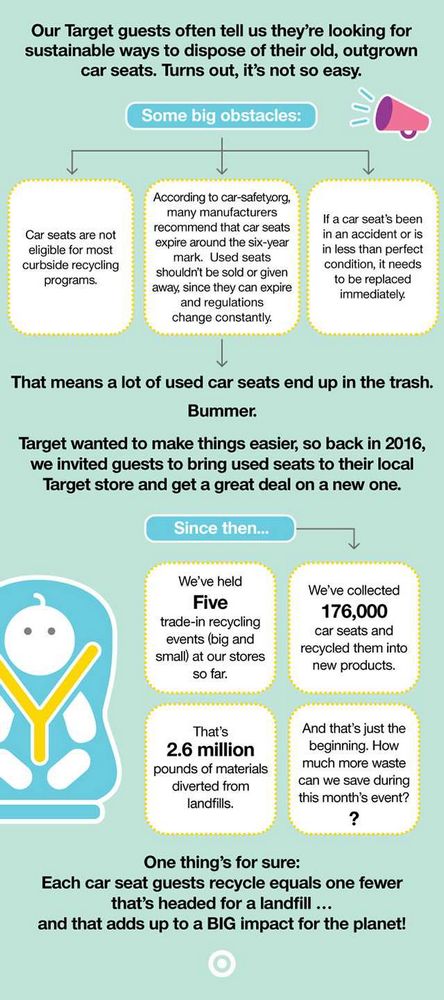
When it comes to car safety, one of the most important things you can do for your child is to ensure they have a properly installed car seat. Car seats are designed to protect infants, toddlers, and young children in the event of a car accident, and they can significantly reduce the risk of injury or death.
However, car seats have an expiration date, and once they have reached that date or have been involved in a car accident, they should no longer be used. So, what should you do with your old car seat? One option is to participate in a car seat trade-in program.
A car seat trade-in program allows you to safely dispose of your old car seat while also receiving a discount on a new one. Many retailers and organizations offer these programs, where you can bring in your old car seat and receive a discount on a new one, often a toddler or booster seat. This not only ensures that your child has a safe and up-to-date car seat but also helps to reduce waste by properly disposing of the old seat.
It’s important to note that not all car seat trade-in programs are the same, so it’s essential to do your research and find a program that meets your needs. Some programs may only accept infant car seats, while others may accept all types of car seats. Additionally, some programs may only offer a discount on a specific brand or model of car seat, so it’s important to read the fine print before participating.
Why Should You Trade In Your Old Car Seat?

Trading in your old car seat is a smart decision for several reasons. First and foremost, it ensures the safety of your toddler or infant while traveling in a car. Car seats have expiration dates, and using an expired or damaged seat can put your child at risk in the event of an accident. By trading in your old car seat, you can ensure that you are using a seat that meets the latest safety standards and provides optimal protection for your child.
Additionally, trading in your old car seat allows you to take advantage of discounts or promotions offered by retailers. Many stores offer special deals or discounts when you trade in your old car seat for a new one. This can help you save money while still ensuring the safety of your child.
Furthermore, trading in your old car seat is an environmentally friendly choice. Instead of simply throwing it away, trading it in allows for proper disposal and recycling of the seat’s components. This helps reduce waste and minimize the impact on the environment.
In summary, trading in your old car seat is a win-win situation. It prioritizes the safety of your child, allows you to take advantage of discounts, and promotes environmental sustainability. So, don’t hesitate to trade in your old car seat and invest in a new one that provides the best possible safety for your little one.
Safety Concerns
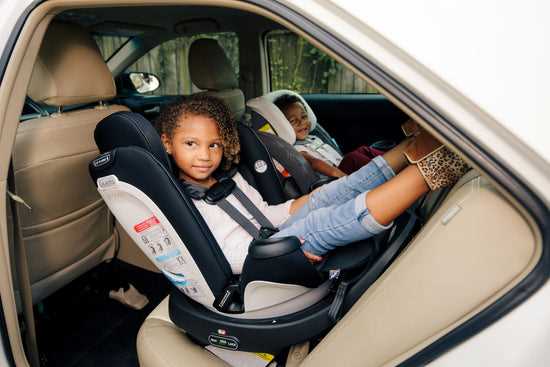
When it comes to car seats, safety should always be the top priority. It is important to properly dispose of old car seats to ensure that they do not end up in the wrong hands or get used in an unsafe manner.
Infant car seats, booster seats, and other types of car seats have expiration dates. This is because the materials used in car seats can degrade over time, reducing their effectiveness in protecting children in the event of a car accident. Additionally, car seat technology is constantly evolving, and newer models often have improved safety features.
Trading in your old car seat is a great way to ensure its safe disposal. Many retailers offer car seat trade-in programs, where you can bring in your old car seat and receive a discount on a new one. This not only helps you save money, but it also ensures that your old car seat will be properly disposed of.
When trading in your car seat, it is important to follow the retailer’s guidelines. This may include removing the cover, straps, and other accessories from the seat. Some retailers may also require you to bring in the original packaging or proof of purchase. By following these guidelines, you can help ensure that the car seat will be properly recycled or disposed of.
Remember, safety should always come first when it comes to car seats. By properly disposing of your old car seat through a trade-in program, you can help ensure that it will not be used in an unsafe manner and that it will be properly recycled or disposed of. This will not only protect your child but also contribute to a safer environment for everyone.
Proper Installation
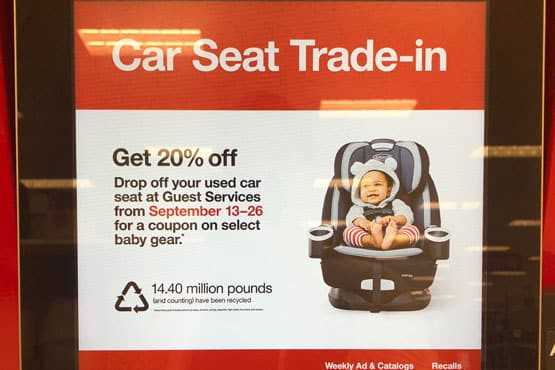
Proper installation of a car seat is crucial for the safety of your child. When you trade in your old car seat for a discount on a new one, it is important to ensure that the new seat is installed correctly.
There are different types of car seats available, including infant seats, toddler seats, and booster seats. Each type has its own installation requirements, so it is important to carefully read the manufacturer’s instructions before installing the seat.
When installing an infant car seat, make sure to use the base that comes with the seat. The base should be securely installed using either the vehicle’s seat belt or the LATCH system. The seat itself should be placed in the base and securely attached.
For toddler and booster seats, it is important to use the vehicle’s seat belt to secure the seat. Make sure the seat belt is properly threaded through the correct slots and is tightly secured. The seat should be securely attached to the vehicle and should not move more than one inch in any direction.
Proper installation also includes adjusting the seat to fit your child correctly. The harness straps should be at or below the child’s shoulders for rear-facing seats and at or above the child’s shoulders for forward-facing seats. The chest clip should be at armpit level and the straps should be snug, with no slack.
Remember, proper installation of a car seat is essential for your child’s safety. If you are unsure about how to install a car seat correctly, consult the manufacturer’s instructions or seek help from a certified car seat technician.
Expiration Dates

When it comes to car seats, safety is of utmost importance. One key factor to consider is the expiration date of the seat. Just like any other product, car seats have a limited lifespan. This is because the materials used in the seat can degrade over time, compromising its ability to protect an infant, child, or booster seat in the event of a car accident.
Car seat manufacturers typically provide an expiration date on the seat itself or in the accompanying manual. It is important to adhere to this expiration date and replace the seat when it has expired. Using an expired car seat can put a child’s safety at risk.
Expired car seats should not be used, donated, or sold. Instead, they should be properly disposed of to ensure they are not used by someone else. Many retailers and organizations offer car seat trade-in programs, where you can bring in your old car seat and receive a discount on a new one. These programs are a great way to safely dispose of your expired car seat while also saving money on a new one.
When participating in a car seat trade-in program, it is important to follow the guidelines provided by the retailer or organization. This may include disassembling the car seat, removing any fabric or padding, and ensuring that the seat is no longer usable. Once the seat has been properly prepared, it can be traded in for a discount on a new car seat.
By adhering to expiration dates and participating in car seat trade-in programs, you can ensure that your child is always riding in a safe and secure car seat. Remember, safety should always be the top priority when it comes to your child’s transportation.
Recalls and Defects
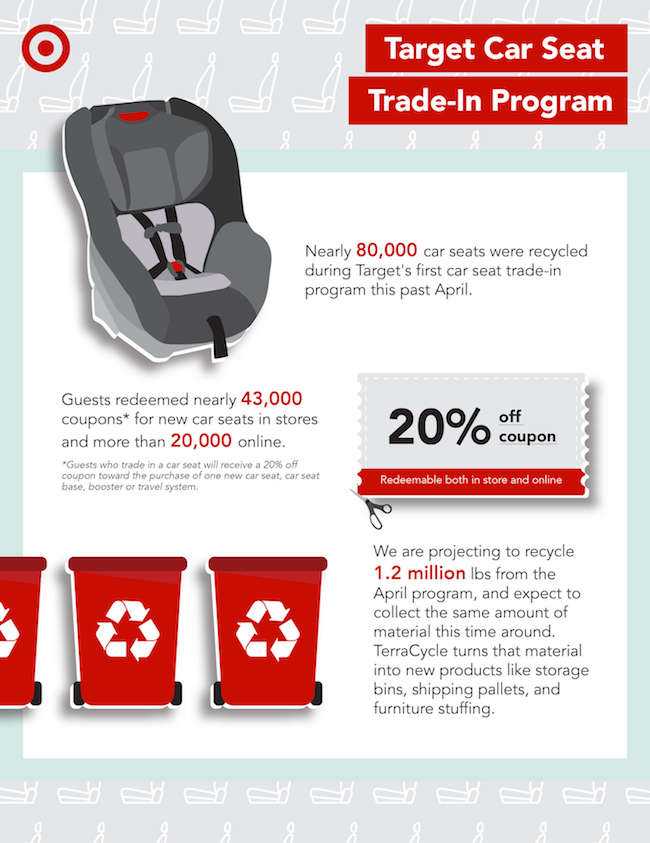
Ensuring the safety of your child is of utmost importance when it comes to car seats. Unfortunately, sometimes car seats can have defects or be subject to recalls. It is crucial to stay informed about any recalls or defects that may affect your car seat.
Manufacturers often issue recalls if they discover a safety issue with a particular car seat model. These recalls can be due to defects in the design, materials, or manufacturing process. If your car seat is subject to a recall, it is important to take immediate action to address the issue.
One way to stay informed about recalls and defects is to register your car seat with the manufacturer. By doing so, you will receive notifications if there are any recalls or safety notices for your specific car seat model. Additionally, you can regularly check the manufacturer’s website or the National Highway Traffic Safety Administration (NHTSA) website for any updates on recalls or defects.
If your car seat is recalled, the manufacturer will typically provide instructions on how to remedy the issue. This may involve sending you a repair kit or replacement parts, or it may require you to return the car seat for a refund or discount on a new one. It is important to follow the manufacturer’s instructions carefully to ensure the safety of your child.
When trading in your old car seat for a new one, it is essential to ensure that the old car seat is properly disposed of. If the car seat has been recalled or has any defects, it should not be passed on to another family or used again. Instead, it should be rendered unusable by cutting the straps and removing any padding or covers. This will prevent anyone from mistakenly using a defective or unsafe car seat.
By staying informed about recalls and defects, you can ensure that your child’s car seat is always safe and secure. Regularly checking for recalls and registering your car seat with the manufacturer are simple steps that can help protect your child’s safety on the road.
| Recalls and Defects |
|---|
| Ensuring the safety of your child is of utmost importance when it comes to car seats. Unfortunately, sometimes car seats can have defects or be subject to recalls. It is crucial to stay informed about any recalls or defects that may affect your car seat. |
| Manufacturers often issue recalls if they discover a safety issue with a particular car seat model. These recalls can be due to defects in the design, materials, or manufacturing process. If your car seat is subject to a recall, it is important to take immediate action to address the issue. |
| One way to stay informed about recalls and defects is to register your car seat with the manufacturer. By doing so, you will receive notifications if there are any recalls or safety notices for your specific car seat model. Additionally, you can regularly check the manufacturer’s website or the National Highway Traffic Safety Administration (NHTSA) website for any updates on recalls or defects. |
| If your car seat is recalled, the manufacturer will typically provide instructions on how to remedy the issue. This may involve sending you a repair kit or replacement parts, or it may require you to return the car seat for a refund or discount on a new one. It is important to follow the manufacturer’s instructions carefully to ensure the safety of your child. |
| When trading in your old car seat for a new one, it is essential to ensure that the old car seat is properly disposed of. If the car seat has been recalled or has any defects, it should not be passed on to another family or used again. Instead, it should be rendered unusable by cutting the straps and removing any padding or covers. This will prevent anyone from mistakenly using a defective or unsafe car seat. |
| By staying informed about recalls and defects, you can ensure that your child’s car seat is always safe and secure. Regularly checking for recalls and registering your car seat with the manufacturer are simple steps that can help protect your child’s safety on the road. |
Environmental Impact
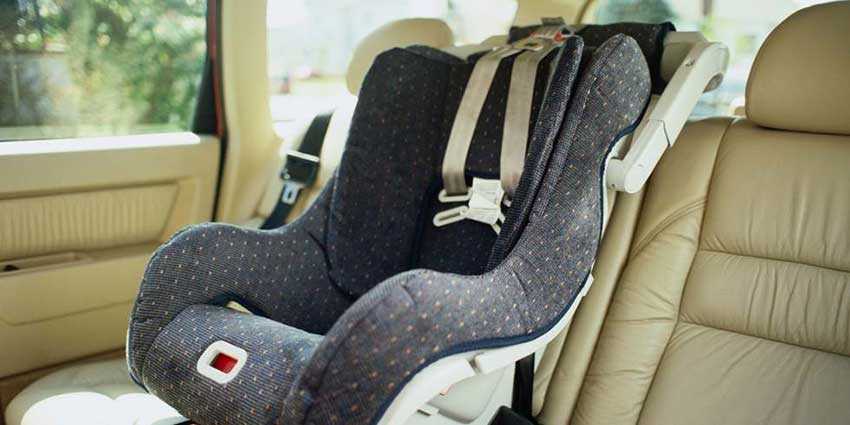
When it comes to car seats, their impact on the environment is a significant concern. Car seats are typically made from a combination of plastic, metal, and foam, which are not easily biodegradable. This means that when a car seat is disposed of in a landfill, it can take hundreds of years to break down.
Additionally, car seats often contain flame retardant chemicals, which can be harmful to the environment when they leach into the soil and water. These chemicals can also pose a risk to human health.
However, there are ways to mitigate the environmental impact of car seats. One option is to participate in a car seat trade-in program. Many retailers offer discounts on new car seats when you trade in your old one. This not only ensures that the old car seat is disposed of properly, but it also encourages the use of newer, safer models.
Another option is to donate your old car seat to a local organization or charity. They may be able to refurbish the seat and provide it to a family in need. This not only reduces waste but also helps ensure that more children have access to safe car seats.
If your car seat is no longer usable or cannot be donated, it’s important to dispose of it properly. Check with your local waste management facility to see if they accept car seats for recycling. Some facilities may require you to disassemble the seat and separate the different materials before recycling.
By taking steps to properly dispose of your old car seat, you can help minimize its environmental impact and contribute to a safer and more sustainable future.
FAQ about topic Car Seat Trade In: How to Safely Dispose of Your Old Car Seat
What is the purpose of a car seat trade-in program?
The purpose of a car seat trade-in program is to provide a safe and responsible way for parents to dispose of their old car seats. It allows them to trade in their old car seats for a discount on a new one, while ensuring that the old seats are properly recycled and not reused or resold.
How does a car seat trade-in program work?
A car seat trade-in program typically works by allowing parents to bring their old car seats to a participating retailer. The retailer then collects the car seats and ensures that they are properly recycled. In return, the parents receive a discount on a new car seat or other baby gear.
Why is it important to dispose of old car seats properly?
It is important to dispose of old car seats properly because they can pose a safety risk if they are reused or resold. Car seats have expiration dates and can become worn out or damaged over time, which can compromise their effectiveness in protecting a child in a car accident. By properly disposing of old car seats, parents can help ensure that they are not being used by someone else and potentially putting a child at risk.
Can I recycle my old car seat?
Yes, you can recycle your old car seat. Many retailers and organizations offer recycling programs specifically for car seats. These programs ensure that the car seats are properly disassembled and recycled, with the materials being used to make new products. It is important to check with your local recycling center or retailer to see if they accept car seats for recycling.
What should I do if my car seat is expired?
If your car seat is expired, it is recommended to dispose of it and purchase a new one. Car seats have expiration dates for a reason – they are designed to provide optimal safety for a certain period of time. Using an expired car seat can put your child at risk in the event of a car accident. Look for a car seat trade-in program or contact your local recycling center to properly dispose of the expired car seat.
What should I do with my old car seat?
If your car seat is expired or damaged, it is recommended to dispose of it properly. You can participate in a car seat trade-in program offered by various retailers or contact your local recycling center for guidance on how to recycle the car seat components.
I am Lena N. Blackwell, a passionate writer and the author behind the content you find on vpequipments.in.
My work covers a range of topics including babies, culture, food, garden, holidays, pregnancy, tips, and travel. I strive to provide valuable insights and information to help parents, families, and individuals navigate through various aspects of life. My goal is to create content that is not only informative but also engaging and relatable, making your journey a little bit easier and more enjoyable.